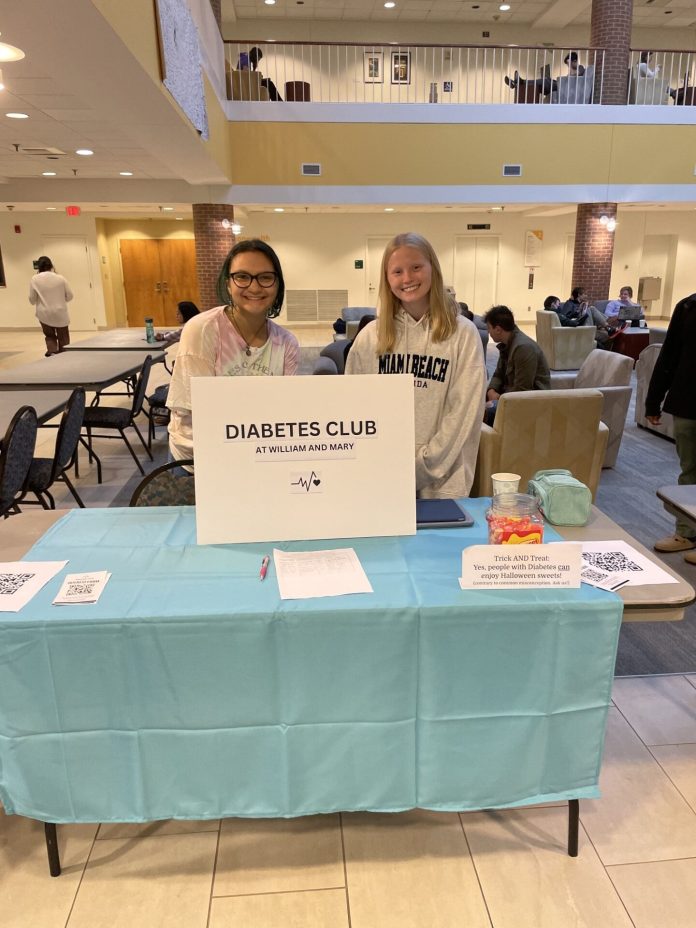Statistics say that there are diabetics all around us, but those with the invisible disease are constantly faced with misinformation and often create communities to associate with those they can relate to. However, up until recently, there has been no organization for diabetics on the College of William and Mary’s campus.
The need for a group that could connect diabetics and any others who wanted to be involved did not go unnoticed by co-founder Annika Natividad ’26, a Type 1 diabetic who has been diagnosed for over a decade.
“I knew that there was someone on campus that was going through the same thing I was. I was really missing the community that I had in my hometown,” Natividad said. “I’ve been very involved with a lot of Type 1 stuff back in Fredericksburg, Virginia. There’s a summer camp for Type 1 kids. There’s just a very big network of people that support you through your diagnosis and just living with it, and I hadn’t really gotten that here, especially living on your own with Type 1. It’s a really big transition.”
While applying to found such a group, it didn’t take long for Natividad to connect with someone else affected by diabetes. Co-founder Katherine Criswell ’27 had also begun the process of starting a Diabetes Club, and the two were connected by the school. Now operating as a team, the pressure of starting a club alone was lifted off of Criswell’s shoulders.
“It was really relieving because I was doing the constitution and all of that by myself, and founding the club. I was worried about ‘how am I going to find people interested in this,’” Criswell said. “So it was a blessing that there was someone else who wanted the same thing as me, and we could work together to accomplish this common goal.”
The club’s recent founding has not hindered any camaraderie by the members, who have already begun to develop a group passionate about awareness and education. Nick Hoelting ’27, who has previously been involved with the Juvenile Diabetes Research Foundation, expressed appreciation for finding a similar sense of community on campus.
“Some of them don’t have diabetes and some of them do, but they all have a really positive outlook,” Hoelting said. “It’s lot’s of good people, and it’s very reassuring and positive, which would say I value a lot about the club.”
Current members emphasized that the greater College community should know that this club is not just for those diagnosed with diabetes. Often comically and affectionately referred to as having Type 3 diabetes, family and friends of diabetics are more than welcome to join.
“A big misconception for the Diabetes Club is that only people with diabetes can join,” Natividad said. “We’re considering changing our name to something with either education or awareness, or something like that in it, so that it brings in a different demographic of people.”
The community aspect of the club is only one side of its mission and effect. The education provided by the presence of the organization is something that members expressed a desire to capitalize on.
“It’s just the fact that we’re here and we’re present on campus and people with or without diabetes of any kind can join and learn,” Natividad said.
The club has already faced some of the common misconceptions about diabetes, like about its causes, the differences in the types, the risks and complications and the realities of the life of a diabetic, including stereotypical comments from passersby during the club’s tabling. This has made members realize the need for education even more.
“I feel like most people kind of think it’s just a label of a bad lifestyle, rather than a legitimate disease that needs treatment,” Hoelting said.
Ultimately, dispelling feelings of loneliness through a welcoming environment is something that Criswell remains passionate about as the club continues to make a name for itself on campus.
“I’m hoping that this can bring some joy and a sense of, ‘I’m not the only one with this,’ to other people too,” Criswell said.

